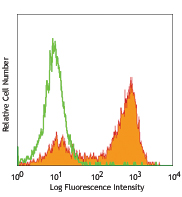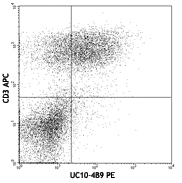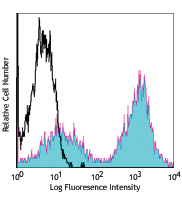- Regulatory Status
- RUO
- Other Names
- IL-12p70, IL-1α, IL-1β, IL-3, IL-12p40, IL-23, IL-7, IL-11, IL-27, IL-33, IFN-β, GM-CSF, TSLP
- Ave. Rating
- Submit a Review
- Product Citations
- publications
Cytokines are small soluble glycoproteins that act as extracellular signaling molecules and mediate communications between cells. They regulate immunity, inflammation and hematopoiesis as well as cell growth, migration, development and differentiation. Cytokines act in large tightly regulated networks where both the production and action of one cytokine is affected by the behavior of other cytokines. The accurate measurement of the expression profile of cytokines in a sample is critical to complete and in-depth understanding of disease progression and immune responses.
The LEGENDplex™ Mouse Cytokine Panel 2 (13-plex) V02 kit is a multiplex bead-based assay, using fluorescence–encoded beads intended for use on various flow cytometers. This panel allows simultaneous quantification of 13 mouse cytokines, including IL-1α, IL-1β, IL-3, IL-7, IL-11, IL-12p40, IL12p70, IL-23, IL-27, IL-33, IFN-β, GM-CSF and TSLP. This assay panel provides higher detection sensitivities and broader dynamic ranges than the traditional ELISA method. The panel has been validated for use on cell culture supernatant, serum and plasma samples.
A LEGENDplex™ Mix and Match system is available to customize assays for specificities within this cytokine panel.
Kit Contents
- Kit Contents
-
- Setup Beads: PE Beads
- Setup Beads: Raw Beads
- LEGENDplex™ Mouse Cytokine Panel 2 Premixed Beads V02
- LEGENDplex™ Mouse Cytokine Panel 2 Detection Antibodies V02
- LEGENDplex™ Mouse Cytokine Panel 2 Standard V02
- LEGENDplex™ Matrix C, Lyophilized
- LEGENDplex™ SA-PE
- LEGENDplex™ Assay Buffer
- LEGENDplex™ Wash Buffer, 20X
- Plate Sealers
- V-bottom Plate
Product Details
- Verified Reactivity
- Mouse
- Application
-
Multiplex - Panel
Learn more about LEGENDplex™ at biolegend.com/legendplex
Download the LEGENDplex™ software here. - Materials Not Included
-
- Flow Cytometer
- Pipettes and Tips
- Reagent Reservoirs for Multichannel Pipettes
- Polypropylene Microfuge Tubes
- Vortex Mixer
- Sonicator
- Aluminum Foil
- Absorbent Pads or Paper Towels
- Plate Shaker
- Tabletop Centrifuges
- Centrifuge with a swinging bucket adaptor for microtiter plates (if using V-bottom plates)
- 1.1 mL polypropylene micro FACS tubes, in 96-tube rack
Antigen Details
- Biology Area
- Cell Biology, Immunology, Innate Immunity, Neuroinflammation, Neuroscience
- Molecular Family
- Cytokines/Chemokines
- Gene ID
- 16175 View all products for this Gene ID 16176 View all products for this Gene ID 16187 View all products for this Gene ID 16159 View all products for this Gene ID 16160 View all products for this Gene ID 83430 View all products for this Gene ID 16196 View all products for this Gene ID 16156 View all products for this Gene ID 246779 View all products for this Gene ID 77125 View all products for this Gene ID 15977 View all products for this Gene ID 12981 View all products for this Gene ID 53603 View all products for this Gene ID
Related Pages & Pathways
Pages
Related FAQs
- If I don't have a vacuum, how do I remove the liquid from my plate?
-
If you do not have a vacuum, the assay should be run in a V-bottom plate. After centrifugation using a swinging-bucket rotor with a plate adaptor, you can remove the liquid by flicking the plate quickly, dumping the contents into a sink, and patting it dry carefully on a stack of clean paper towels without losing the beads. Alternatively, you can remove the liquid by using a pipette.
- Should I perform the assay with the filter plates or with V-bottom plates?
-
Filter plates or V-bottom plates have been included in some kits for your convenience. A vacuum filtration unit is required to work with the filter plates. However, if you don’t have access to a vacuum manifold or if you prefer, then you can use the V-bottom plates and follow the recommended assay protocols for the type of plates you choose. All plates should be made from low binding polypropylene. Polystyrene ELISA or cell culture plates should not be used.
- After I finish the staining process, how long can I wait before reading my LEGENDplex™ samples?
-
The samples can be kept overnight at 4°C while being protected from exposure to light and be read the next day. There may be a decrease in signal, but overall, the assay results should not be affected. Storing the samples for extended periods of time is not recommended, as it could lead to further reductions in signal.
- What is the shelf life of LEGENDplex™ kits?
-
LEGENDplex™ kits are guaranteed for 6 months from the date of receipt, but may have a shelf life of up to 2 years from the date of manufacture.
- Is special software required for data analysis?
-
Typically flow cytometers generate output files in FCS format (e.g. FCS 2.0, 3.0, or 3.1) and in some cases in list mode file format (LMD). Other software may be available to analyze FCS files. Data generated using LEGENDplex™ kits can be analyzed using the freely available LEGENDplex™ data analysis software. Please check our website for the most updated versions of the software.
Customers Also Purchased



 Login / Register
Login / Register 









Follow Us